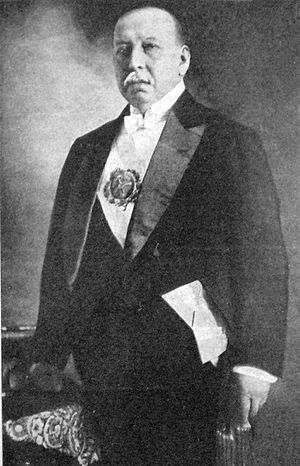Victorino de la Plaza facts for kids
Quick facts for kids
Victorino de la Plaza
|
|
|---|---|

de la Plaza with the presidential sash.
|
|
| President of Argentina | |
| In office 10 August 1914 – 11 October 1916 |
|
| Vice President | Vacant |
| Preceded by | Roque Sáenz Peña |
| Succeeded by | Hipólito Yrigoyen |
| Vice President of Argentina | |
| In office 12 October 1910 – 9 August 1914 |
|
| President | Roque Sáenz Peña |
| Preceded by | José Figueroa Alcorta |
| Succeeded by | Pelagio Luna |
| Personal details | |
| Born | 2 November 1840 Payagosta, Salta, Argentina |
| Died | 2 October 1919 (aged 78) Buenos Aires, Argentina |
| Political party | National Autonomist Party |
| Spouse | Epifanía Ecilda Belvis Castellanos (1870–1875) |
| Profession | Lawyer |
Victorino de la Plaza (born November 2, 1840 – died October 2, 1919) was an important Argentine politician and lawyer. He served as the President of Argentina from 1914 to 1916. Before becoming president, he was the Vice President of Argentina from 1910 to 1914.
Victorino de la Plaza was the second son of José Roque Mariano de la Plaza Elejalde and Manuela Silva. His older brother, Rafael de la Plaza, was also a politician who became the governor of Santiago del Estero Province. Victorino de la Plaza was the last president of what is known as the "conservative period" in Argentine history, which ended when a new law made voting secret and compulsory for everyone.
Early Life and Education
Victorino de la Plaza was born on November 2, 1840, in Payagosta, a place in Salta Province, Argentina. His parents were Jose Mariano Roque de La Plaza y Elejalde and Maria Manuela Silva. After his father passed away, his mother took care of raising him and his brother, Rafael.
Victorino started school in a public school in Argentina. However, he soon moved to a Franciscan convent to continue his education. As a child, he worked to help his family. He sold newspapers, sweets, and empanadas that his mother made. Later, he started working as an attorney and a scribe, which is someone who copies documents. In 1859, he passed an exam to become a "rotary," a type of legal official.
He received a scholarship from the government, which allowed him to study at the Colegio de Uruguay. He attended this school between 1859 and 1862. After that, he moved to Buenos Aires to study at the University of Buenos Aires. He was a very good student. Because of his excellent studies, President Mitre appointed him as a clerk in the National Accounting Office in 1864.
Military Service
Victorino de la Plaza had a short time in the military. When the Triple Alliance War began, he stopped his university studies to join an Artillery Regiment. He became an assistant to General Julio de Vedia. General de Vedia was an important military leader in Argentina.
Victorino de la Plaza fought in two major battles: the Battle of Estero Bellaco on May 2, 1866, and the Battle of Tuyuti on May 24 of the same year. For his bravery, the Government of Uruguay gave him the Silver Sol medal for Estero Bellaco and the Cords of Honor for Tuyuti. Bartolome Mitre, who was president at the time, promoted him to the rank of Captain. He also received a special mention for his heroism. However, he had to return to Buenos Aires because he became ill.
Studying Law
When he returned to Buenos Aires, Victorino de la Plaza continued his studies at the Law faculty at Buenos Aires University. He finished his law degree on July 13, 1868. His main project for graduation was called "Credit as Capital." His mentor was Dalmacio Velez Sarsfield, a very famous lawyer. Victorino de la Plaza worked as a scribe for Dalmacio Velez Sarsfield while he was writing the Civil Code, which is a set of laws that govern daily life in Argentina.
Political Career
After his military service and law studies, Victorino de la Plaza began a long career in politics. He held several important positions in the Argentine government.
- In 1876, he became the Treasury Minister under President Nicolás Avellaneda. This role meant he was in charge of the country's money.
- In 1878, he was appointed as an "Interventor" in Corrientes Province. This meant he was sent to manage the province's affairs during a difficult time.
- Later, he served as Foreign Minister in 1882. This role involved handling Argentina's relationships with other countries.
- From 1883 to 1885, he was again the Treasury Minister during the first presidency of Julio Argentino Roca.
In 1910, Victorino de la Plaza was elected Vice President. He ran with Roque Sáenz Peña as part of the National Union party. When President Sáenz Peña passed away in 1914, Victorino de la Plaza became the President of Argentina. He served as president until 1916. After leaving office, he retired from politics. He passed away on October 2, 1919, due to pneumonia.
See also
In Spanish: Victorino de la Plaza para niños

